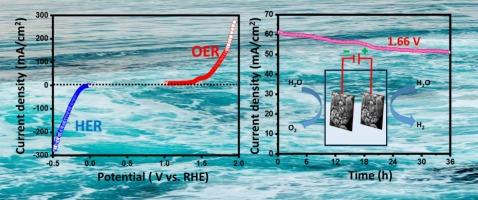Phosphorus-doped CuS@NF: A promising bifunctional electrocatalyst for enhanced water splitting efficiency
IF 6.9
2区 材料科学
Q2 CHEMISTRY, PHYSICAL
引用次数: 0
Abstract
Benefiting from merits such as high electrical conductivity, non-toxicity and low cost, copper sulfides are considered one of the most promising electrocatalysts for both of oxygen evolution reaction (OER) and hydrogen evolution reaction (HER) activities in KOH electrolytes. Nonetheless, this electrocatalyst has indicated high overpotential in previous studies. To address this problem, this work introduces a phosphorus-doped copper sulfide on nickel foam (CuS@NF) as the electrocatalyst with spherical morphology, synthesized through a simple two-step process, for both the oxygen evolution reaction (OER) and hydrogen evolution reaction (HER). Electrochemical tests showed that P-doped CuS@NF exhibited excellent catalytic performance with overpotentials of 170 mV for OER and 255 mV for HER at a current density of 50 mA/cm2. In comparison, the undoped CuS@NF catalyst required overpotentials of 310 mV for OER and 347 mV for HER under the same conditions. Furthermore, P-doped CuS@NF demonstrated improved stability over its undoped counterpart. Density functional theory (DFT) calculations confirmed that phosphorus doping significantly lowered the overpotentials, especially for the OER, highlighting the enhanced activity of this non-noble metal catalyst.


掺磷CuS@NF:一种有前途的提高水分解效率的双功能电催化剂
由于具有高导电性、无毒性和低成本等优点,硫化铜被认为是KOH电解液中析氧反应(OER)和析氢反应(HER)活性最有前途的电催化剂之一。尽管如此,这种电催化剂在以前的研究中显示出高过电位。为了解决这一问题,本研究在泡沫镍上引入了一种掺磷硫化铜(CuS@NF)作为球形电催化剂,通过简单的两步法合成了析氧反应(OER)和析氢反应(HER)。电化学测试表明,在电流密度为50 mA/cm2时,掺p的CuS@NF具有优异的催化性能,OER的过电位为170 mV, HER的过电位为255 mV。相比之下,在相同条件下,未掺杂的CuS@NF催化剂的OER和HER的过电位分别为310 mV和347 mV。此外,p掺杂CuS@NF比其未掺杂的对应物表现出更好的稳定性。密度泛函理论(DFT)计算证实,磷掺杂显著降低了过电位,特别是OER,突出了这种非贵金属催化剂的活性增强。
本文章由计算机程序翻译,如有差异,请以英文原文为准。
求助全文
约1分钟内获得全文
求助全文
来源期刊

Applied Surface Science
工程技术-材料科学:膜
CiteScore
12.50
自引率
7.50%
发文量
3393
审稿时长
67 days
期刊介绍:
Applied Surface Science covers topics contributing to a better understanding of surfaces, interfaces, nanostructures and their applications. The journal is concerned with scientific research on the atomic and molecular level of material properties determined with specific surface analytical techniques and/or computational methods, as well as the processing of such structures.
 求助内容:
求助内容: 应助结果提醒方式:
应助结果提醒方式:


